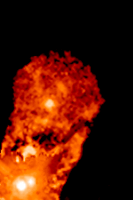astro.wikisort.org - Star
XZ Tauri is a binary system approximately 460 light-years away in the constellation Taurus. The system consists of two T Tauri stars orbiting each other about 6 billion kilometers apart (roughly the same distance as Pluto is from the Sun). The system made news in 2000 when a superflare was observed in the system.
 A visual band light curve for XZ Tauri. The main plot shows the long-term variability, and the inset shows the year 2000 superflare on the north star. Adapted from Dodin et al. (2016)[1] and Coffey et al. (2004).[2] | |
| Observation data Epoch J2000.0 Equinox J2000.0 | |
|---|---|
| Constellation | Taurus |
| Right ascension | 04h 31m 40.08690s[3] |
| Declination | +18° 13′ 56.6424″[3] |
| Apparent magnitude (V) | 10.40[4] |
| Characteristics | |
| Spectral type | M2.0 + M3.5[5] |
| Astrometry | |
| Proper motion (μ) | RA: 9.1[6] mas/yr Dec.: −17.8[6] mas/yr |
| Distance | 460 ly (140[7] pc) |
| Orbit[8] | |
| Primary | A[lower-alpha 1] |
| Companion | B |
| Period (P) | 155 yr |
| Semi-major axis (a) | 0.172+0.002 −0.003″ |
| Eccentricity (e) | 0.742+0.025 −0.034 |
| Inclination (i) | 0.0° |
| Argument of periastron (ω) (secondary) | −42.2+2.0 −4.7° |
| Details[5] | |
| A[lower-alpha 1] | |
| Mass | 0.37 M☉ |
| Radius | 1.1 R☉ |
| Luminosity | 0.17 L☉ |
| B | |
| Mass | 0.29 M☉ |
| Radius | 1.7 R☉ |
| Luminosity | 0.31 L☉ |
| Temperature | 3,550[7] K |
| Age | 4.6[7] Myr |
| Other designations | |
| Database references | |
| SIMBAD | data |
A third star, component C, has been observed at a separation of 0.09″, but subsequent observations failed to find it.[10][8] The T Tauri star HL Tauri, 23″ away, is also sometimes listed as a companion.[9]
Gallery
![Hubble image of XZ Tauri.[11]](//upload.wikimedia.org/wikipedia/commons/thumb/b/bc/Heic1424a.tif/lossy-page1-200px-Heic1424a.tif.jpg)
 An animation of the 2000 superflare in the system.
An animation of the 2000 superflare in the system.
Notes
- Sources vary on their definitions of the primary and secondary components. A is defined here as the more massive component, with a lower temperature but higher luminosity. Other sources refer to the components as north and south,[lower-alpha 2] or Aa and Ab.[lower-alpha 3] The southerly star Ab is generally brighter at optical wavelengths and more massive, but is less luminous.
References
- Dodin, A. V.; Emelyanov, N. V.; Zharova, A. V.; Lamzin, S. A.; Malogolovets, E. V.; Roe, J. M. (January 2016). "Orbital motions and light curves of young binaries XZ Tau and VY Tau". Astronomy Letters. 42 (1): 29–40. arXiv:1509.04966. Bibcode:2016AstL...42...29D. doi:10.1134/S1063773716010035. S2CID 118495210.
- Coffey, D.; Downes, T. P.; Ray, T. P. (May 2004). "The evolution and simulation of the outburst from XZ Tauri – A possible EXor?". Astronomy and Astrophysics. 419 (2): 593–598. Bibcode:2004A&A...419..593C. doi:10.1051/0004-6361:20034316. S2CID 17421498.
- Brown, A. G. A.; et al. (Gaia collaboration) (August 2018). "Gaia Data Release 2: Summary of the contents and survey properties". Astronomy & Astrophysics. 616. A1. arXiv:1804.09365. Bibcode:2018A&A...616A...1G. doi:10.1051/0004-6361/201833051. Gaia DR2 record for this source at VizieR.
- Ducati, J. R. (2002). "VizieR Online Data Catalog: Catalogue of Stellar Photometry in Johnson's 11-color system". CDS/ADC Collection of Electronic Catalogues. 2237. Bibcode:2002yCat.2237....0D.
- Hartigan, Patrick; Kenyon, Scott J. (January 2003). "A Spectroscopic Survey of Subarcsecond Binaries in the Taurus-Auriga Dark Cloud with the Hubble Space Telescope". The Astrophysical Journal. 583 (1): 334–357. arXiv:astro-ph/0209608. Bibcode:2003ApJ...583..334H. doi:10.1086/345293. S2CID 10433035.
- Zacharias, N.; Urban, S. E.; Zacharias, M. I.; Wycoff, G. L.; Hall, D. M.; Germain, M. E.; Holdenried, E. R.; Winter, L. (2003). "UCAC2 Catalogue (Zacharias+ 2004)". Vizier Online Data Catalog. Bibcode:2003yCat.1289....0Z.
- Osorio, Mayra; et al. (July 2016). "A Dwarf Transitional Protoplanetary Disk around XZ Tau B". The Astrophysical Journal Letters. 825 (1): 6. arXiv:1606.03118. Bibcode:2016ApJ...825L..10O. doi:10.3847/2041-8205/825/1/L10. S2CID 59585588. L10.
- Ichikawa, Takanori; Kido, Miyu; Takaishi, Daisuke; Shimajiri, Yoshito; Tsukamoto, Yusuke; Takakuwa, Shigehisa (2021). "Misaligned Circumstellar Disks and Orbital Motion of the Young Binary XZ Tau". The Astrophysical Journal. 919 (1): 55. arXiv:2106.11924. Bibcode:2021ApJ...919...55I. doi:10.3847/1538-4357/ac0dc3. S2CID 235593373.
- "XZ Tau". SIMBAD. Centre de données astronomiques de Strasbourg. Retrieved 2020-12-09.
- Osorio, Mayra; MacÍas, Enrique; Anglada, Guillem; Carrasco-González, Carlos; Galván-Madrid, Roberto; Zapata, Luis; Calvet, Nuria; Gómez, José F.; Nagel, Erick; Rodríguez, Luis F.; Torrelles, José M.; Zhu, Zhaohuan (2016). "A Dwarf Transitional Protoplanetary Disk Around Xz Tau B". The Astrophysical Journal. 825 (1): L10. arXiv:1606.03118. Bibcode:2016ApJ...825L..10O. doi:10.3847/2041-8205/825/1/L10. S2CID 59585588.
- "Jets, bubbles, and bursts of light in Taurus". www.spacetelescope.org. ESA/Hubble. Retrieved 6 November 2014.
External links
- "Movies from Hubble Show the Changing Faces of Infant Stars". HubbleSite. NASA. 21 September 2000. Retrieved 23 August 2009.
- XZ Tauri at Constellation Guide
На других языках
[de] XZ Tauri
XZ Tauri (abgekürzt XZ Tau) ist ein Doppel- oder Dreifachsternsystem[3][4] im Sternbild Stier, das sich in der Taurus-Molekülwolke befindet und etwa 450 Lichtjahre von der Erde entfernt ist. Das System wird durch zwei variable T-Tauri-Sterne gebildet, die einen gemeinsamen Schwerpunkt in einem Abstand von 6 Milliarden Kilometer (etwa der Distanz von Sonne zu Pluto) umlaufen.[3] Eine Untersuchung aus dem Jahr 2009 deutet darauf hin, dass ein Stern noch einen nahen Begleitstern hat, so dass es sich insgesamt ein Dreifachsternsystem ergibt.[4]- [en] XZ Tauri
Текст в блоке "Читать" взят с сайта "Википедия" и доступен по лицензии Creative Commons Attribution-ShareAlike; в отдельных случаях могут действовать дополнительные условия.
Другой контент может иметь иную лицензию. Перед использованием материалов сайта WikiSort.org внимательно изучите правила лицензирования конкретных элементов наполнения сайта.
Другой контент может иметь иную лицензию. Перед использованием материалов сайта WikiSort.org внимательно изучите правила лицензирования конкретных элементов наполнения сайта.
2019-2025
WikiSort.org - проект по пересортировке и дополнению контента Википедии
WikiSort.org - проект по пересортировке и дополнению контента Википедии
![Hubble image of XZ Tauri.[11]](http://upload.wikimedia.org/wikipedia/commons/thumb/b/bc/Heic1424a.tif/lossy-page1-200px-Heic1424a.tif.jpg)
